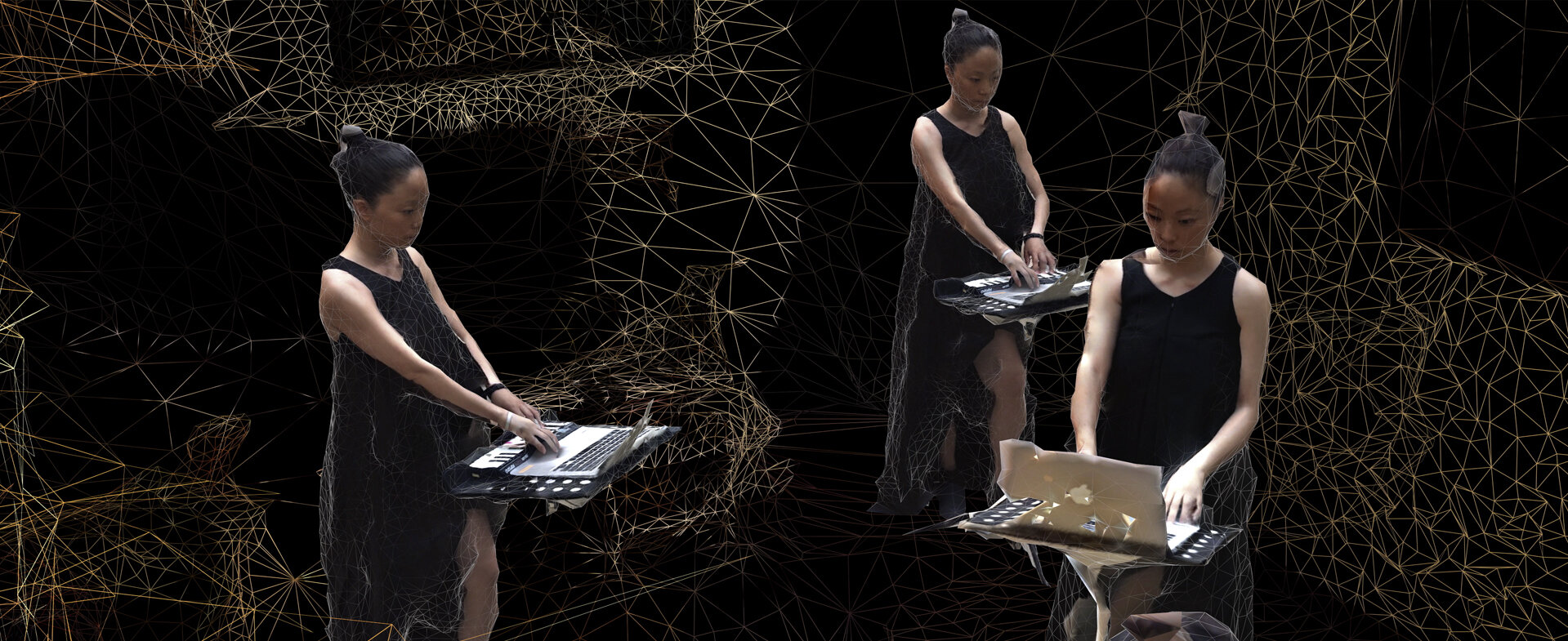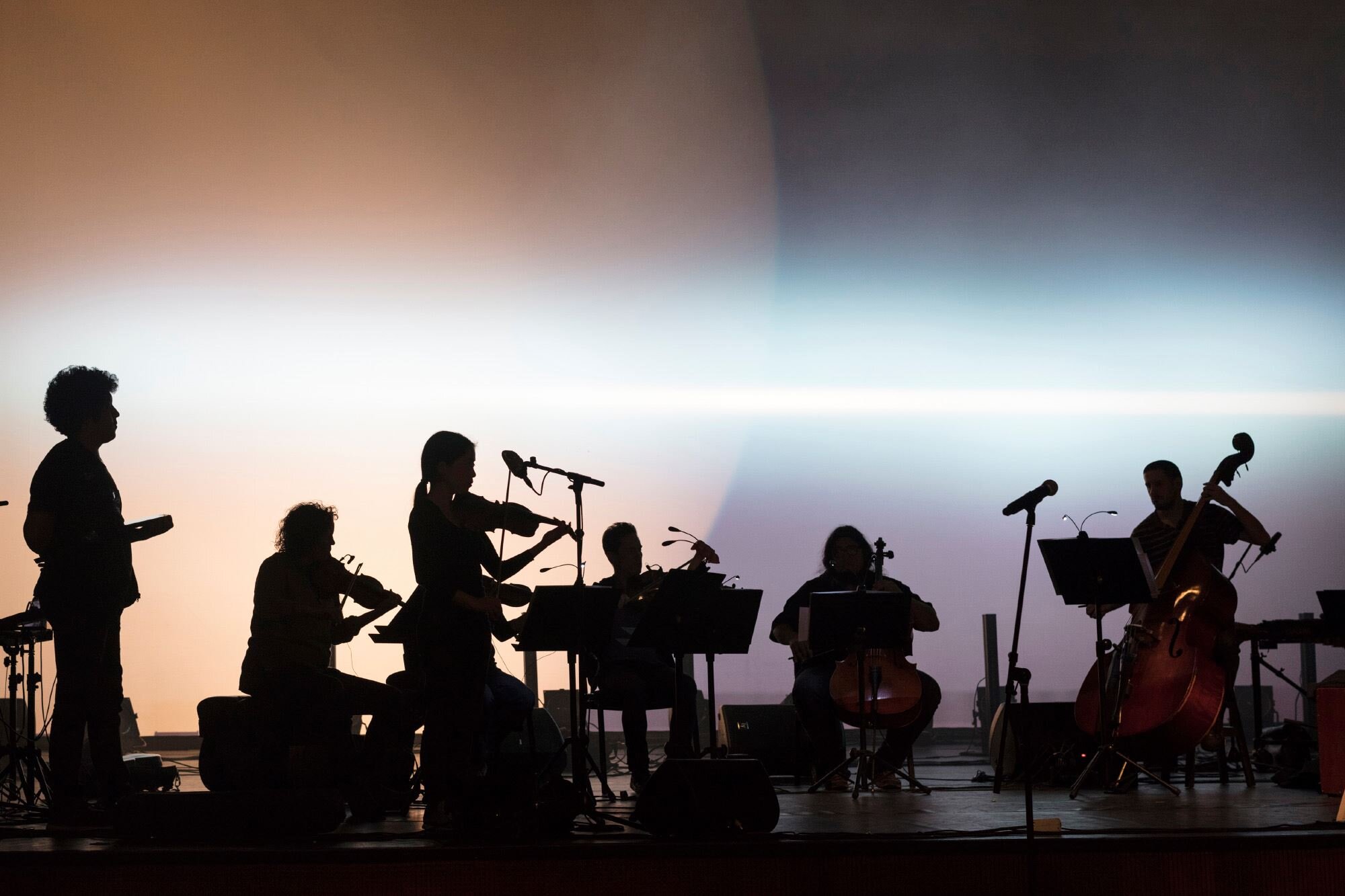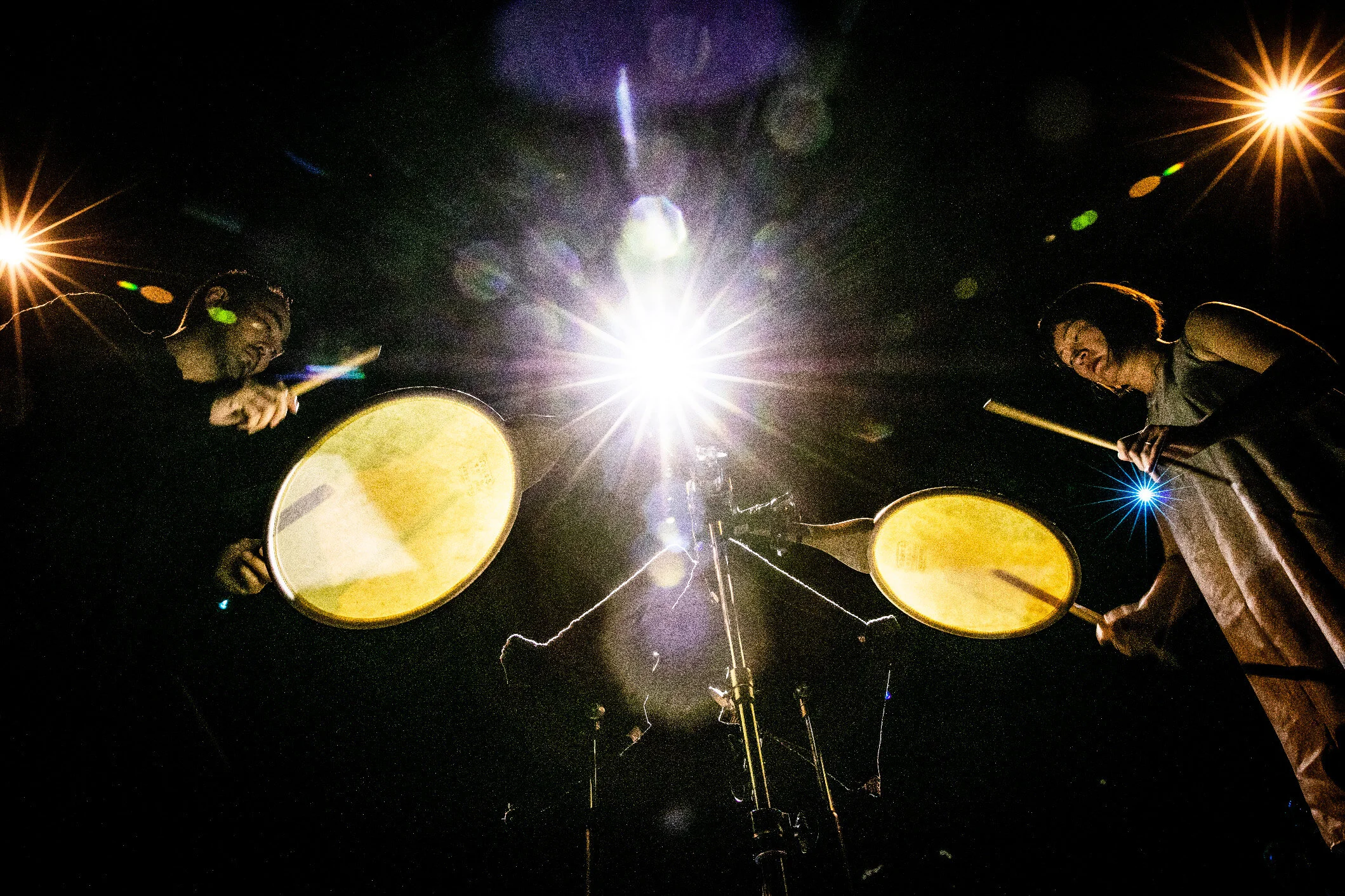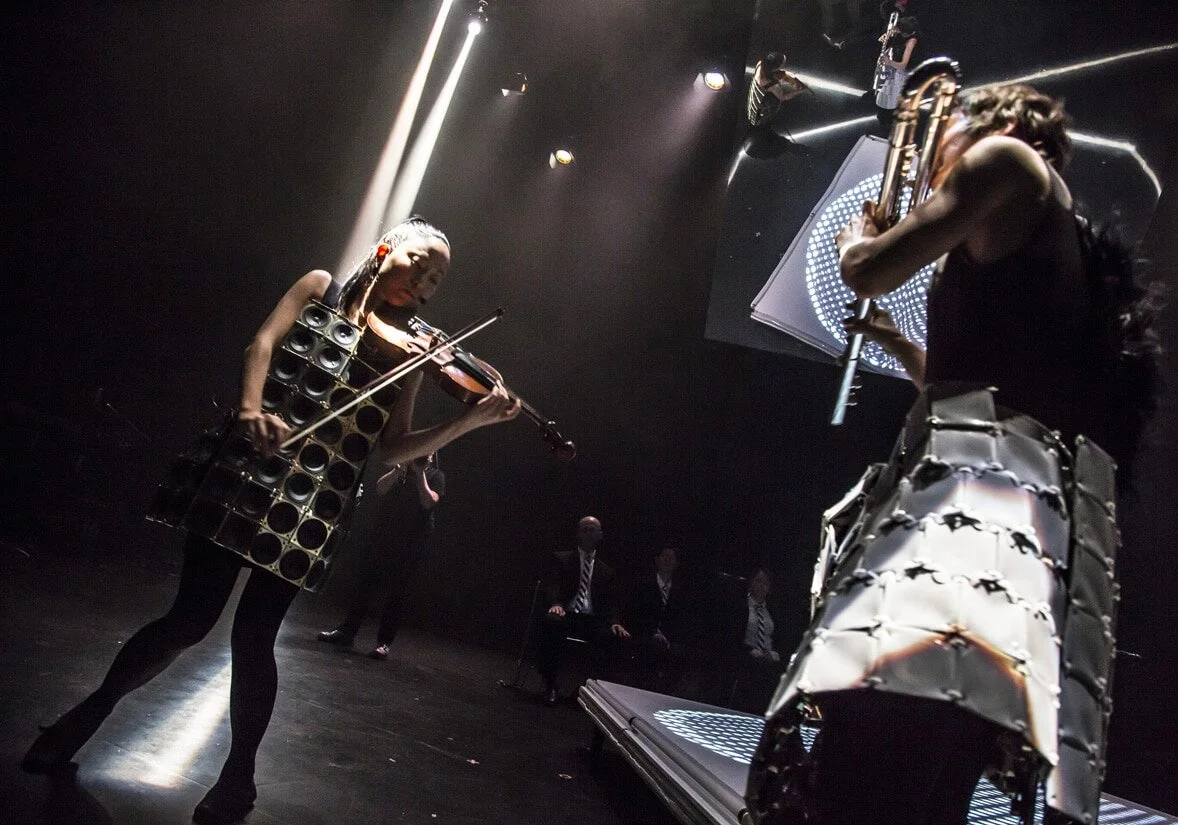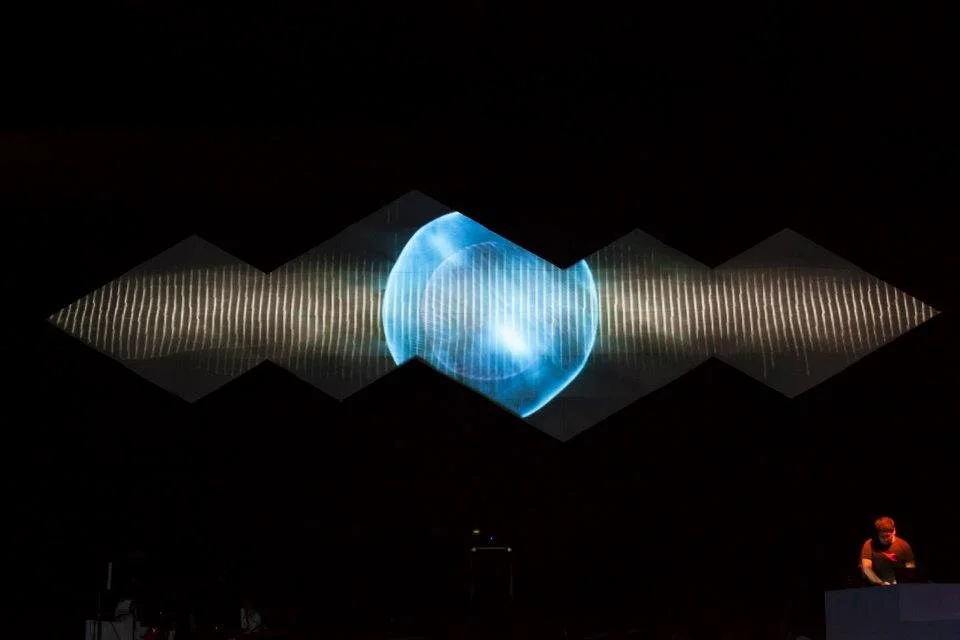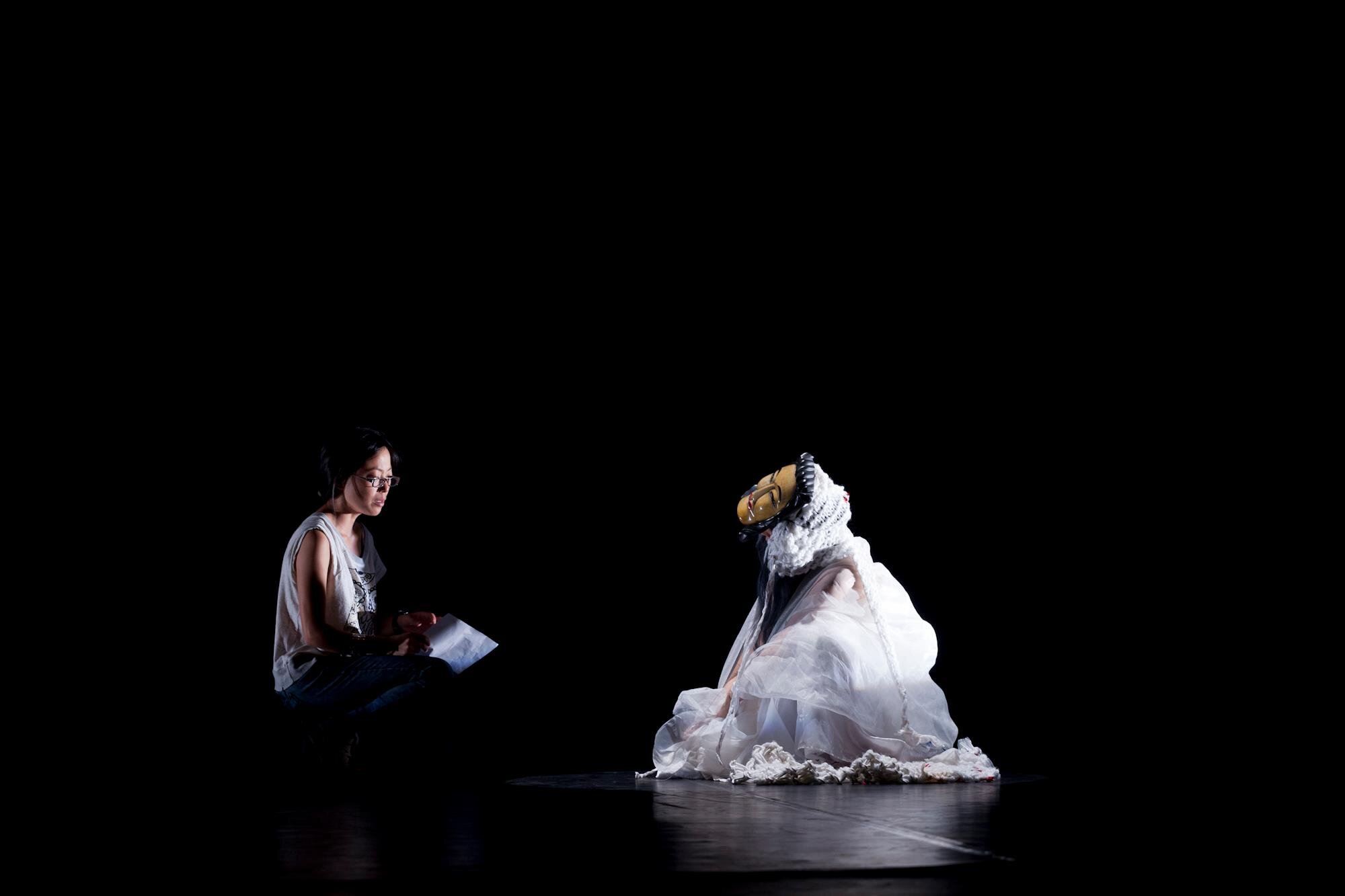Commissioned by Americas Society
Composition for string quintet, percussion, voice, and electronics. Video with 3D scans and animation.
Commissioned by Espacio Fundación Telefónica
Composition for solo violin and electronics. Perfomatic experience through 360° video and animation.
Commissioned by Balich Worldwide Shows
Composition and arrangements of the Peruvian National anthem, a symphony that combines more than 40 native Peruvian languages, and an electronic version of the timeless "El Cóndor Pasa" that included samples of iconic diva Yma Sumac.
Commissioned by Silkroad Ensemble
Composition for Galician Bagpipe in G, Tabla, Chinese Bells, Uchiwa Daiko I, Uchiwa Daiko II, Bass Drum, Small Frame Drum, Cajon, Vibraphone, Kemanche, Violin I, Violin II, Viola, Violoncello, Double Bass, and Electronics. Video with 3D scans and animation.
Commissioned by Patronato Cultural del Perú for the the 16th Venice Architecture Biennale
Sound installation & Film score for the exhibition “UNDERCOVER” at the Peruvian Pavilion in Arsenale.
Commissioned by Aizuri Quartet
Composition for string quartet and clarinet. Premiered at the Metropolitan Museum of Art in NY.
Commissioned by Gran Teatro Nacional del Peru & Rolex Arts Weekend
Audiovisual concert for string quintet, percussions, piano and electronics.
Commissioned by Carnegie Hall & ACO
Composition for orchestra and electronics. As part of the program ORCHESTRA UNDERGROUND: REFLECTED IN GLASS—PHILIP GLASS AND THE NEXT GENERATION
Commissioned by the Pnea Foundation for Density 2036: part iv
Performative composition for Bass Flute, Violin, Electronic Live Processing, 2 Vocals, and 2 Speaker Dresses. Premiered at The Kitchen NYC
Commissioned by Teatro Municipal de Lima
Operatic multimedia performance for ensemble, electronics, video art, dance, and butoh. Presented at FAEL Festival.
Multi format project that involved the design of multimedia performances, sound installations, audiovisual concerts and the development of self-designed instruments.
Experimental public interventions where a wide rage of scenic formats were explored: from a small public toilet with 15 listeners to a sold out opera house.
k’uKu
2020
Composition for string quintet, percussion, voice, and electronics
Composed by Pauchi Sasaki
A project by Pauchi Sasaki commissioned by Americas Society
In collaboration with visual artist Juan Carlos Yanaura
Performers
Pauchi Sasaki
Voice & electronics
Haruka Fujii
Percussion
Emily Daggett Smith
Violin*
Nanae Iwata
Violin*
Kyle Armbrust
Viola*
Jane Cords-O'Hara
Cello*
Logan Coale
Bass*
*Musicians from The Knights
“k’uKu” videoclip
Program Notes
Shot during the COVID confinement in cities across the US and in Lima, the source video material is 3D scans made by the musicians with their phones in their homes and studios. These images become figures and environments that are in constant dialogue. Commissioned by Americas Society, k'uKu ('Unripe Fruit' in Quechua) was originally conceived as a site-specific multimedia performance to take place in New York's Central Park and became a site-specific place for the virtual space created by Sasaki and Yanaura. Performers will include members of the orchestral collective The Knights alongside percussionist Haruka Fujii and Sasaki herself on voice.
Score
TAPAO ORCCOY
2020
Composition for solo violin and electronics
Composed by Pauchi Sasaki
A project by Pauchi Sasaki commissioned by 1° Feria Virtual de Discos y Sellos Discográficos organized by Espacio Fundación Telefónica, Museo de Arte Contemporáneo de Lima (MAC) y Contrapedal.
In collaboration with visual artist Juan Carlos Yanaura
360° video
Program Notes
The new normal forces us to look for other ways of relating to our environment. Despite social restrictions and confinement, we artists have not stopped creating. Given the impossibility of presenting ourselves in public, we have quickly adapted to the virtual world. Many of us have already registered our performances, and curiously enough, we have coincided in digitally recreating natural spaces, searching for amplitude and freedom. I ask myself: If in traditional cultures, forests are inhabited by magical beings, is it possible that this new nature also develops its own mystical level? "Tapao Orccoy" explores the idea of virtual animism and the interaction of our subjectivity with this second nature.
Pan americaN games opening ceremony
2019
Composition and arrangements for orchestra, choir, and electronics.
Commissioned by Balich Worldwide Shows for the Pan American Games Opening Ceremony Lima 2019.
Symphony of Languages
Based on the original poem “El Perú” by Marco Martos with music by Pauchi Sasaki.
Voice and translation by Delfina Paredes, Marilú Iroba, Hermenegildo Espejo, Edwin Phala, Wilmer Ancón y Cynthia Palomino - Cultural Ministry of Perú. Orchestra Sinfonía por el Perú. Copying by Gabriel Vizcarra.
Peruvian Anthem
Version by Pauchi Sasaki based on the original music by José Bernardo Alcedo and original lyrics by José de la Torre Ugarte.
Voices by Javier Sunico (choir director), Augusto Casafranca, Ana Correa, Teresa Ralli, Julián Vargas, Marco Campos, Mónica Canales, Hatun Killa, Xavier Fernández, Estefanía Castilla. Orquesta Sinfonía por el Perú. Copying by Gabriel Vizcarra.
El Cóndor Pasa Remix
Music by Pauchi Sasaki with samples of the voice of Yma Sumac. Based on "El Cóndor Pasa” by Daniel Alomía Robles.
Credits
Carlos Cuya & Mono/Stereo Studio
Sound Supervisor
Francisco Negrin
Creative Director
Vania Masías
Choreographer
Pepe Corzo
Costume Designer
Balich Worldwide Shows
Production
THE NATION | Peruvian Anthem
A unique version of the National Anthem especially created for the Pan American Games Opening Ceremony. The choreography was inspired by the Peruvian Sign Language. Photo by Luca Parisse
THE CUTTING EDGE | El Cóndor Pasa Remix
To the sound of a new version of "El Cóndor Pasa” and in homage to Peruvian singer and icon Yma Sumac, models walk down the catwalk wearing costumes of the past and the present. Magnificent clothes are born of Perú’s vibrant fabrics. Both the most spectacular folk costumes and the most contemporary designs are worthy of a great fashion show. This section ends with the performance of dancers in costumes inspired by the Tapadas Limeñas. Photo by Buda Mendes
THE NATION | Symphony of Languages
A sound montage and dance choreography based on the poem “El Perú” by Marco Martos which gathers different languages spoken in Peru. The design with 49 “nodes” on the field represents the 49 Peruvian languages. Lines of text create paths on the scenography, and finally, they come together, shaping the national flag of Peru.
Score
elektra
2019
Composition for Galician Bagpipe in G, Tabla, Chinese Bells, Uchiwa Daiko I, Uchiwa Daiko II, Bass Drum, Small Frame Drum, Cajon, Vibraphone, Kemanche, Violin I, Violin II, Viola, Violoncello, Double Bass, and Electronics.
Composed by Pauchi Sasaki
Commissioned by Silkroad Ensemble
”ELEKTRA” is part of Silkroad’s multimedia project “Heroes Take Their Stand” created by Ahmad Sadri more
Premiered at UC Santa Barbara and performed at Younes and Soraya Nazarian Center for the Performing Arts, Segerstrom Center for the Arts, Cal Performances Zellerbach Hall, and The John F. Kennedy Center for the Performing Arts.
Creative team
Pauchi Sasaki
Composer
Nomi Sasaki
Video Co-direction, Script, Art Design, and Chinese Black Ink Animation
Juan Carlos Yanaura
Video Co-direction, Animation, and Post Production
Omar Lavalle
Video 3D Scanning and Sculpture Design
Reviews
LA Times
San Francisco Classical Voice
Independent
Origin Stories: The making of “Heroes Take Their Stand” by Silkroad | Photo by Max Whittaker
Program Notes
Among the best-known Greek tragedies, the story of ‘Elektra’ is told in many different ways. In Sophocles’ version, she is consumed with the idea of murdering her own mother because of profound loyalty to her unjustly murdered father: the injustice of his death at the hand of her mother’s new lover fuels Elektra’s quest for justice even when she suspects her brother — prophesied to complete the deed — is dead. Sophocles has us pay close attention to Elektra’s attempts to process, understand, and explain her own emotions and convictions to herself, as well as to the others. In this sense, Elektra strives to convince her plan’s fairness, and her battle is not one fought with horses and artillery but inside herself. In the end, she achieves the justice she has long sought, though the outcome is both blood-soaked and bittersweet. Composer Pauchi Sasaki and visual artists Nomi Sasaki and Juan Carlos Yanaura bring us into Elektra’s subjectivity and internal conflict — one deeply resonant with today’s struggles with social media, truthfulness, and independent thought — using a combination of tabla, uchiwa daiko, and augmented reality, among other elements.
Dueling Taiko Drums: an excerpt of “Elektra” | Photo by Max Whittaker
Score
huacas
2018
Sound installation & Film score by Pauchi Sasaki presented at 16th Venice Architecture Biennale
Huacas is part of the project “UNDERCOVER” and was commissioned by Patronato Cultural del Perú
Credits
José Orrego Herrera
Commissioner
Marianela B. Castro De La Borda, Janeth Boza, and Javier Lizarzaburu Montani.
Curators
Toshio Pardo Tanamachi, Alejandro Lapouble Barrios, and Lucero Chiclla Díaz
Collaborators
Pauchi Sasaki / Sound Installation (with the support of the Rolex Mentor and Protégé Arts Initiative)
Invited artist
Nomi Sasaki
Assistance
Patronato Cultural del Perú
Production
Catalogs
Peruvian Pavilion
16th Venice Architecture Biennale
Huacas: Sound as a subjective dimension of space
A sound installation inspired by a network of more than 400 ancient temples in Lima city
Each of the sounds we perceive in our daily life is predetermined by the space where the listening event happens. Spaces are resonators that sculpt and transform percussion, music, noise. Architecture and sound have a function in common: just as iconic buildings and monuments help us to navigate a city, sound enables us to determine distances and locate our position in space. Ancient Peru's civilizations were no strangers to this dual relationship, integrating acoustics into their structures as an essential design element [1]. This sound installation is inspired by the intrinsic relationship between space and sound. On the one hand, it presents the act of listening as the most subjective approximation to an understanding of the architectural experience. On the other, it recognizes architecture as a form of sound composition, with urban planning as the score.
The way sound spatialization behaves in this installation follows fundamental guidelines in ancient Peru. The Andean worldview takes into account the four horizontal compass points marking space (North, South, East, and West) as well as the vertical directions of abstract territories: hanan pacha (the world above, the realm of the gods, the cosmos), kay pacha (this material world, the here and now) and uku pacha (the underworld, the world within). An eighth one is added to these directions: Chaupin (the center), which has been studied by Peruvian architect Mario Osorio [2]. This concept of space differs significantly from the Western notion since it integrates space-time with the individual's perspective.
Huacas, recently explored and shown in this exhibition, serve as compasses pointing us toward an understanding of the city in the context of time. They are symbols, and to understand them, it is necessary to acknowledge their relational nature. Just as isolated words acquire meaning within the structure of language, Huacas and their irrigation networks form a powerful syntax capable of transforming the territory.
Video part of the Peruvian exhibition “UNDERCOVER” produced by Universidad de Lima and scored by Pauchi Sasaki | Photo by Leonardo Ramirez
This sound installation is an exercise in approaching a foundational language's profound nuances and the perception of their relationships and connections to time and to the place where they unfold.
[1] The following studies make the case that ancient Peruvians devised sound design through architecture: Lumbreras, L.G., González C. and Lietaer B., 1976. “Acerca de la función del sistema hidráulico de Chavín”. Lima, Museo Nacional de Antropología y Arqueología. J.S Abel, J.W. Rick, P. P. Huang, M. A. Kolar, J. O. Smith, and J. M. Chowing, 2008. “On the Acoustics of the Underground Galleries of Ancient Chavín de Huántar, Peru”. In: Acoustics 08. Paris.
[2] Osorio Olazábal, M., 1988. “Estructuras de Observación Chaupin”. First edition. Lima: Nicolsa.
Diente de León
2018
Composition for string quartet and clarinet
Composed by Pauchi Sasaki
Commissioned by Aizuri Quartet, quartet-in-residence at the Metropolitan Museum of Art in NY.
“Diente de León” was part of the program “Music & Migration” which premiered at MET’s Grace Rainey Rogers Auditorium.
“Diente de León” performed by Aizuri Quartet
Program Notes
This piece is inspired by the plant Diente de León (tiger's tooth in Spanish) or Dandelion. It reflects the uncertainty of migration: as well as this plant's flying seeds do not know where they are going to land finally; migrators also ignore the exact latitudes of their new soil and where they will start a new life cycle. It also explores the blurring nature of memories, as migrators try to rebuild their place of origin in their minds. A new subjective and individual space is then constructed based on nostalgia and will.
Score
GAMA XVI: for orchestra and electronics
2017
Composition for orchestra and electronics. As part of the program ORCHESTRA UNDERGROUND: REFLECTED IN GLASS—PHILIP GLASS AND THE NEXT GENERATION
Composed by Pauchi Sasaki
Commissioned by Carnegie Hall and American Composers Orchestra
In collaboration with visual artist Nomi Sasaki
Premiered at Zankel Hall | Carnegie Hall
Performers
George Manahan
Music Director and Conductor
American Composers Orchestra
Orchestra
Tim Fain
Violin Soloist
Pauchi Sasaki
Electronics and Speaker Dress
Full Program
Carnegie Hall
Reviews
The New York Classical Review
The New York Times
Welt
Le Point
Fash Nerd
I CARE IF YOU LISTEN
Program Notes
GAMA XVI is a performative electroacoustic composition for orchestra and speaker dress—a wearable sound sculpture made out of 100 speakers. This piece is divided into three short movements. The medium/machines are tools that are constantly shaping our creative process and imagination. As an electroacoustic composer, I decided to build a critical and personal relationship with technology by designing and building my own instruments. As performers, we unconsciously develop a body language around our instruments. Our bodies “dance” while playing, searching for pathways to fuse sound’s emission with gesture and physicality. In this sense, I design searching for each interface’s potential to deliver personal gestures.
Score
GAMA | OMAGUA
2017 - 2018
Audiovisual concert for string quintet, percussions, piano, and electronics.
Commissioned by Gran Teatro Nacional del Peru and Rolex Arts Weekend
Presented at Gran Teatro Nacional del Peru in Lima, Deutsches Theater in Berlin, National Sawdust’s Pan Asia Festival in NYC, Philip Glass’ Days and Nights Festival in California, Les Creatives Festival in Geneve, and Festival Cervantino in Guanajuato-Mexico.
Creative team
Pauchi Sasaki
Direction, Concept, and Music Composition
Nomi Sasaki
Artistic Production, Animation, and Chinese Ink
Juan Carlos Yanaura
Animation and Post Production
Omar Lavalle
Animation and Visual Programming
Franklin Quintanilla
Light Design and Programming
Reviews
The Economist
The Guardian
Independent
Full programs
Rolex Arts Weekend 2018, Berlin
Gran Teatro Nacional 2017, Lima
“Mayu” for violin soloist, string quintet, and electronics. Featuring violinist Jennifer Curtis.
Program Notes
GAMA
In the first half of “GAMA XV: Piece for Two Speaker Dresses”, human bodies become sound instruments, providing a new experience of sound embodiment to performers. The composition evidences the performers’ movement lexicon, as well as their pre-logos use of voice. The second half of the composition integrates the performers’ traditional instrumentation. “Borealis” − a heavily electronic piece – then explores the idea of being sound itself, the experience of being bodies of sound. In “MAYU” (cocoon of silkworm 繭 in Japanese and river in Quechua), the image of a river sets the compositional structure of the piece. “Sanagi” (which means stage inside the cocoon in Japanese) describes the process of manifestation: the transformation of an abstraction − living in a space without gravity or any evident order − to a defined stream of energy. The overall soundscape describes how the space is constantly changing its shape, a place that breathes and is alive. The morphing behaviour is described by the oscillation between the parameters of pressure and looseness, harmony and dissonance, discontinuity and rhythm, timid whispers and strong affirmations and releases of sound.
“Sanagi” for multi-percussion solo, string quartet, and electronics. Featuring percussionist Aleksandra Šuklar | Photo by Leonardo Ramirez
OMAGUA
In the Peruvian Amazon, OMAGUA means “the region of sweet water fish”. This suite is a selection of pieces inspired by musical landscapes of the composer’s native country. “Social Dance” recalls the coastal region and its ballroom tradition. “Padrecocha” is inspired by cumbia music and its exuberant amplification throughout the Amazon’s fluvial piers. Finally, “La Montaña” represents the Andean tradition of pilgrimage. Every year, thousands of people all over the cordillera hike up very high mountains to make their offerings to the Apus, or mountain gods. These festivities last for many days and are full of music, dance and devotion.
GAMA XV: Piece for two speaker dresses
2016
Performative composition for Bass Flute, Violin, Electronic Live Processing, 2 Vocals, and 2 Speaker Dresses
Composed by Pauchi Sasaki
Written for Claire Chase and commissioned by the Pnea Foundation for Density 2036: part iv
The commission included the design and development of Speaker Dress No. 2
Premiered at The Kitchen NYC and performed at LA Phil, Ojai Festival, Deutsches Theater, Berkeley Art Museum, Days and Nights Festival, National Sawdust.
Album
“Gama XV: Piece for Two Speaker Dresses” was recorded at Meyer Sound’s Pearson Theatre in Berkeley CA with its constellation acoustical system. The release is part of Claire Chase’s Density 2036 four-CD compilation (cycles 2013-2018) [listen]
Reviews
Vice
San Francisco Classical Voice
San Francisco Gate
I CARE IF YOU LISTEN
San Diego Tribune
Full performance of “Gama XV: Piece for Two Speaker Dresses” at The Kitchen in 2016 | Photo by Bart Michiels, Rolex©
Program Notes
“Gama XV: Piece for Two Speaker Dresses” is an electroacoustic composition that fuses disciplines such as sound art, fashion, dance, and visual arts in one theatrical experience. This piece explores the relationship between air as a sound source, the body as a medium of sound’s amplification, and space as the container of the element’s interaction. The piece’s structure is divided into 7 micro-movements or cues, where duality sets the composition’s dynamics: oscillations between the parameters of pressure and looseness, harmony and dissonance, discontinuity and rhythm, timid whispers, and strong affirmations, and releases of sound.
This composition features Speaker Dress no.2 (SD2), which is inspired by Claire Chase’s interpretation of the flute and her astonishing performance of the instrument’s extended techniques. The first half of the piece focuses on the performer’s technique before any interaction with an instrument (using vocal effects as a sound source). Flute extended techniques are meant to be performed without the instrument. By wearing the Speaker Dress, human bodies become sound instruments, providing a new experience of sound embodiment to performers. In this section, the composition evidences the performers’ movement lexicon, as well as their pre-logos use of voice. The second half of the composition integrates performers’ traditional instruments. In addition to the visual differences between SD1 and SD2 -SD1 is black and golden, and SD2 is all white-, SD2 differs from the original version in its motivation. SD1’s inspiration is the skin, symbolizing the boundary and filter between objectivity and subjectivity. In SD1 I use my skin as a sound source by scratching a contact mic against the body. While in SD1, a usually soundless skin becomes the sound source for the dress, in SD2, respiration and unintelligible vocal sounds shape the sonic palette.
The overall soundscape describes how space is continuously changing its shape, a place that breathes and is alive. The morphing behavior is achieved by pre-recorded soundscapes amplified through a quadraphonic sound system.
Score
MURU : Fuerza de lo Inevitable
2012
Operatic multimedia performance for ensemble, electronics, video art, dance, and butoh
A project by Pauchi Sasaki commissioned by Teatro Municipal de Lima
Presented at FAEL Festival
Creative Team
Colectivo OIE
Pauchi Sasaki
Omar Lavalle
Juan Carlos Yanaura
Nomi Sasaki
Invited artists
Dohee Lee
Kinya “Zulu” Tsuruyama
Jennifer Curtis
DanceMonks
Collaborators
Tamy Noguchi
Eduardo Hirose
Mario Ráez
Alonso Núñez
Artistic Production
Nomi Sasaki
Scene “La Montaña”: original idea by Pauchi Sasaki & Juan Carlos Yanaura, choreography by Kinya “Zulu” Tsuruyama, video by Juan Carlos Yanaura, music by Pauchi Sasaki y Juan Pablo Aragón. Interactive programming by Juan Carlos Casusol. Video co-producer: Aluzcine | Photo by Eduardo Hirose

